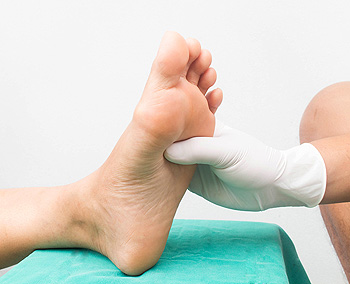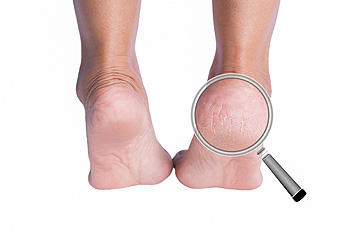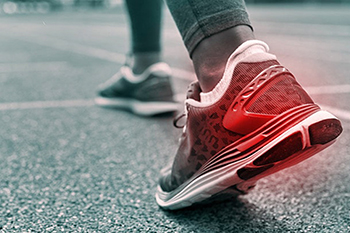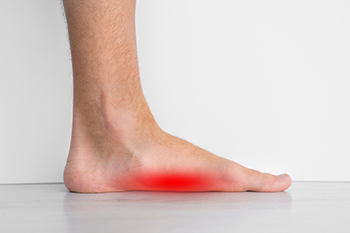July 2022

Anyone with diabetes is subject to foot and lower leg problems, including ulcers, gangrene, and possible amputation. These conditions may be the result of long-term high blood sugar levels, which can cause neuropathy and peripheral artery problems. For that reason, as a diabetic, constant and vigilant care of your feet is essential. If you are unable to check your feet, please ask someone to help you. Some people use a mirror to check the bottom of their feet. Look for changes in skin color; red indicates a problem with your footwear, but blue or black could mean bruising or blood flow problems. Look for blisters or any break in the skin that could become infected. Keep these areas clean and dry, and apply sterile coverings. Check for moisture between the toes, which is a good place for bacterial or fungal infections, such as athlete’s foot, to develop. Notice any numbness, tingling, or inability to detect temperature, hot or cold. Look for sores that do not heal properly, because they may become ulcerated. As a diabetic, it is a good idea to have regularly scheduled visits with a podiatrist who can help to monitor changes to your feet and treat them quickly.
Diabetic foot care is important in preventing foot ailments such as ulcers. If you are suffering from diabetes or have any other concerns about your feet, contact one of our podiatrists from Westside Podiatry Center, LLP. Our doctors can provide the care you need to keep you pain-free and on your feet.
Diabetic Foot Care
Diabetes affects millions of people every year. The condition can damage blood vessels in many parts of the body, especially the feet. Because of this, taking care of your feet is essential if you have diabetes, and having a podiatrist help monitor your foot health is highly recommended.
The Importance of Caring for Your Feet
- Routinely inspect your feet for bruises or sores.
- Wear socks that fit your feet comfortably.
- Wear comfortable shoes that provide adequate support.
Patients with diabetes should have their doctor monitor their blood levels, as blood sugar levels play such a huge role in diabetic care. Monitoring these levels on a regular basis is highly advised.
It is always best to inform your healthcare professional of any concerns you may have regarding your feet, especially for diabetic patients. Early treatment and routine foot examinations are keys to maintaining proper health, especially because severe complications can arise if proper treatment is not applied.
If you have any questions please feel free to contact one of our offices located in Liverpool, Camillus, Skaneateles, Oswego, and Cicero, NY . We offer the newest diagnostic and treatment technologies for all your foot and ankle needs.
 This is much less likely to happen in children than adults because kid’s feet are so tender and mechanical foot factors are not at play yet. However, there are situations where children can have cracked heels. Usually, a child has something abnormal going on with their immune system which impacts the functioning of their skin. Cracks can happen with disorders of nervous system regulation or hormones. Cracked heels can come on with stress, neuropsychic overstrain, or insufficient nutrition, particularly with a deficiency in vitamins B, A, and/or E. If cracks appear, it is usually during a transition period, such as adapting to going to school, the onset of adolescence, or from shock (like in the divorce of parents). Skin can become dry and flaky in response to stressors. As with adults, cracks in children’s feet need attention so as not to become infected and turn into wounds. If your child has cracked heels, protect the heel by covering it with a band-aid, and it is suggested you then take him or her to a podiatrist for appropriate treatment.
This is much less likely to happen in children than adults because kid’s feet are so tender and mechanical foot factors are not at play yet. However, there are situations where children can have cracked heels. Usually, a child has something abnormal going on with their immune system which impacts the functioning of their skin. Cracks can happen with disorders of nervous system regulation or hormones. Cracked heels can come on with stress, neuropsychic overstrain, or insufficient nutrition, particularly with a deficiency in vitamins B, A, and/or E. If cracks appear, it is usually during a transition period, such as adapting to going to school, the onset of adolescence, or from shock (like in the divorce of parents). Skin can become dry and flaky in response to stressors. As with adults, cracks in children’s feet need attention so as not to become infected and turn into wounds. If your child has cracked heels, protect the heel by covering it with a band-aid, and it is suggested you then take him or her to a podiatrist for appropriate treatment.
Cracked heels are unsightly and can cause further damage to your shoes and feet. If you have any concerns, contact one of our podiatrists from Westside Podiatry Center, LLP. Our doctors can provide the care you need to keep you pain-free and on your feet.
Cracked Heels
Cracked heels appear unappealing and can make it harder for you walk around in sandals. Aside from looking unpleasant, cracked heels can also tear stockings, socks, and wear out your shoes. There are several methods to help restore a cracked heel and prevent further damage.
How Do You Get Them?
Dry skin is the number one culprit in creating cracked heels. Many athletes, walkers, joggers, and even swimmers suffer from cracked heels. Age and skin oil production play a role to getting cracked heels as well.
Promote Healing
Over the counter medicines can help, especially for those that need instant relief or who suffer from chronic dry feet.
Wear Socks – Wearing socks with medicated creams helps lock in moisture.
Moisturizers – Applying both day and night will help alleviate dryness which causes cracking.
Pumice Stones – These exfoliate and remove dead skin, which allows for smoother moisturizer application and better absorption into the skin.
Change in Diet
Eating healthy with a well-balanced diet will give the skin a fresh and radiant look. Your body responds to the kinds of food you ingest. Omega-3 fatty acids and zinc supplements can also revitalize skin tissue.
Most importantly, seek professional help if unsure how to proceed in treating cracked heels. A podiatrist will help you with any questions or information needed.
If you have any questions, please feel free to contact one of our offices located in Liverpool, Camillus, Skaneateles, Oswego, and Cicero, NY . We offer the newest diagnostic and treatment technologies for all your foot care needs.

There are several reasons why people choose to run. These include losing weight, training for a marathon, or jogging for pure enjoyment. There are different types of shoes for various styles of running, and it is beneficial to choose the type of shoe that fits comfortably, while enhancing the type of running that is desired. There are many factors that can determine what kind of shoes are purchased. These consist of weight, what type of surfaces are run on, and foot structure. Research has shown foot conditions may be avoided when properly fitting running shoes are worn. These include plantar fasciitis, ankle sprains, and general aches and pains in the foot and arch area. When the right shoes are worn, they are typically comfortable, and feel like they are part of the foot. Many people who enjoy running prefer to shop at a specialty store where they can get advice in matching their foot type to the appropriate shoe. There are different shoes that target a forefoot or heel striker, and it is important to know what type of running is done. If you would like additional information about how to purchase the correct running shoe, please confer with a podiatrist who can answer any questions you may have.
You should always make sure your running shoes fit properly in order to avoid injury. For more information, contact one of our podiatrists from Westside Podiatry Center, LLP. Our doctors can provide the care you need to keep you pain-free and on your feet.
Choosing the Right Running Shoe for Your Foot Type
Improper shoe sizing can cause a myriad of problems for your feet. Shoes that don’t fit you properly can lead to muscular imbalances in your body, which can result in foot, knee, and hip injuries.
Tips for Finding the Right Running Shoe
- Make sure you have a thumb’s width of wiggle room between the end of your longest toe and the front of the shoe.
- There should be little to no slipping at the heel
- Don’t assume your size in one shoe brand will be your size in another
- Do not lace up your shoes too tightly
- Walk around in the store with your new shoes before you buy them
If you have any questions please feel free to contact our one of our offices located in Liverpool, Camillus, Skaneateles, Oswego, and Cicero, NY . We offer the newest diagnostic and treatment technologies for all your foot and ankle needs.

There are millions of people worldwide that are affected by flat feet. They can be a disqualifying condition for people who are interested in joining the military if the symptoms of flat feet are noticeable and present. Some symptoms can include pain in the arch or heel, and the ankles being swollen. Most babies are born with flat feet and the arch typically develops during the teenage years. People who never develop an arch may have no symptoms, or in the opposite case, symptoms may be obvious. These can consist of tiring easily, limited range of foot movement, and there may be a pain in the feet after walking or running. An effective method to determine if you have flat feet involves standing on your tiptoes and looking for an arch in the foot. Doing so may indicate a low arch or the arch may be nonexistent. Some patients perform foot exercises that help flat feet from being achy. If you would like to learn more about exercises and treatments for flat feet, please consult with a podiatrist.
Flatfoot is a condition many people suffer from. If you have flat feet, contact one of our podiatrists from Westside Podiatry Center, LLP. Our doctors will treat your foot and ankle needs.
What Are Flat Feet?
Flatfoot is a condition in which the arch of the foot is depressed and the sole of the foot is almost completely in contact with the ground. About 20-30% of the population generally has flat feet because their arches never formed during growth.
Conditions & Problems:
Having flat feet makes it difficult to run or walk because of the stress placed on the ankles.
Alignment – The general alignment of your legs can be disrupted, because the ankles move inward which can cause major discomfort.
Knees – If you have complications with your knees, flat feet can be a contributor to arthritis in that area.
Symptoms
- Pain around the heel or arch area
- Trouble standing on the tip toe
- Swelling around the inside of the ankle
- Flat look to one or both feet
- Having your shoes feel uneven when worn
Treatment
If you are experiencing pain and stress on the foot you may weaken the posterior tibial tendon, which runs around the inside of the ankle.
If you have any questions please feel free to contact one of our offices located in Liverpool, Camillus, Skaneateles, Oswego, and Cicero, NY . We offer the newest diagnostic and treatment technologies for all your foot and ankle needs.
Blog Archives
- 2025
- 2024
- 2023
- 2022
- 2021
- 2020
- 2019
- 2018
- 2017

